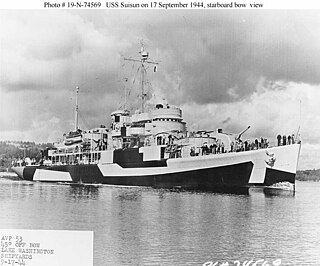
USS Suisun (AVP-53) was a United States Navy Barnegat-class small seaplane tender in commission from 1944 to 1955. It was named for northern California's Suisun Bay, which takes its name from the Native American Suisun tribe.
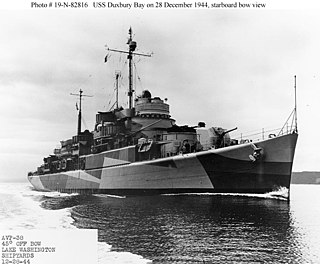
USS Duxbury Bay (AVP-38) was a United States Navy Barnegat-class small seaplane tender in commission from 1944 to 1966.

USS Salisbury Sound (AV-13), a Currituck-class seaplane tender, was laid down on 10 April 1943 by Los Angeles Shipbuilding and Dry Dock Company, San Pedro, California. The ship was originally named Puget Sound, however it was renamed on 5 June 1944, before it was launched on 18 June 1944. Salisbury Sound was sponsored by Mrs. John D. Price, and commissioned on 26 November 1945. She was named after the Salisbury Sound; a sound near Sitka, Alaska and until her decommissioning was affectionately referred to by her crewmembers as the "Sally Sound".
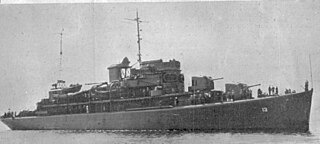
The second USS Mackinac (AVP-13) was a United States Navy Barnegat-class small seaplane tender in commission from 1942 to 1947 that saw service during World War II. After the war, she was in commission in the United States Coast Guard from 1949 to 1967 as the cutter USCGC Mackinac (WAVP-371), later WHEC-371, the second ship of the Coast Guard or its predecessor, the United States Revenue Cutter Service, to bear the name.
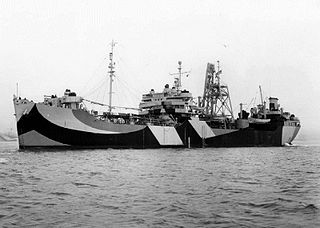
USS Pasig (AW-3) was one of four water distilling ships built for the United States Navy during World War II. The lead ship in her class, she was named for the Pasig River which flows through Manila on the Island of Luzon, Philippines.

USS Gladiator (AM-319) was an Auk-class minesweeper acquired by the U.S. Navy for the dangerous task of removing mines from minefields laid in the water to prevent ships from passing.

USS St. George (AV-16) was a Kenneth Whiting-class seaplane tender in the United States Navy.

USS Chandeleur (AV-10), a seaplane tender, was launched on 29 November 1941 by Western Pipe and Steel Company, San Francisco, California, under a Maritime Commission contract; transferred to the U.S. Navy 19 November 1942; and commissioned the same day.

USS Kenneth Whiting (AV-14) was the lead ship of her class of seaplane tenders in the United States Navy.

USS Hamlin (AV-15) was a Kenneth Whiting-class seaplane tender in the United States Navy.

USS Cumberland Sound (AV-17) was a Kenneth Whiting-class seaplane tender in the United States Navy.
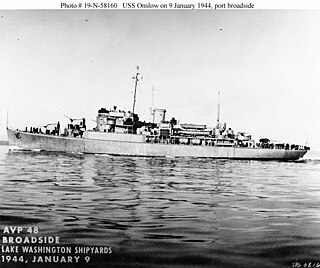
USS Onslow (AVP-48) was a United States Navy Barnegat-class seaplane tender in commission from 1943 to 1947 and from 1951 to 1960.
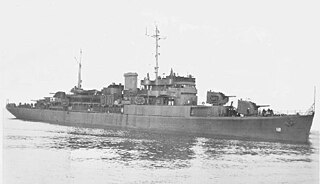
The third USS Casco (AVP-12) was a United States Navy Barnegat-class small seaplane tender in commission from 1941 to 1947. She saw service in World War II. After her decommissioning, the U.S. Navy loaned her to the United States Coast Guard, in which she served as the cutter USCGC Casco (WAVP-370), later WHEC-370, from 1949 to 1969.

USS Yakutat (AVP-32) was a United States Navy Barnegat-class small seaplane tender in commission from 1944 to 1946. Yakutat tended seaplanes in combat areas in the Pacific during the latter stages of World War II. After the war, she was in commission in the United States Coast Guard from 1948 to 1971 as the Coast Guard cutter USCGC Yakutat (WAVP-380), later WHEC-380, seeing service in the Vietnam War during her Coast Guard career. Transferred to South Vietnam in 1971, she was commissioned into the Republic of Vietnam Navy as the frigate RVNS Trần Nhật Duật (HQ-03). When South Vietnam collapsed in 1975 at the end of the Vietnam War, she fled to the Philippines, where the Philippine Navy took custody of her and cannibalized her for spare parts until discarding her in 1982.

USS Shelikof (AVP-52) was a United States Navy Barnegat-class small seaplane tender in commission from 1944 to 1947 and from 1952 to 1954.

The second USS Barataria (AVP-33) was a United States Navy Barnegat-class seaplane tender in commission from 1944 to 1946. She saw service in the later stages of World War II and was decommissioned postwar. She then was transferred to the United States Coast Guard and was in commission as the Coast Guard cutter USCGC Barataria (WAVP-381), later WHEC-381 from 1949 to 1969, serving in the Cuban Missile Crisis and the Vietnam War during her lengthy Coast Guard career.

USS Gardiners Bay (AVP-39) was a United States Navy seaplane tender in commission from 1945 to 1958 that saw service in the latter stages of World War II and in the Korean War. After her decommissioning, she was transferred to Norway, and she served in the Royal Norwegian Navy as the training ship HNoMS Haakon VII (A537) from 1958 to 1974.

The Barnegat class was a large class of United States Navy small seaplane tenders (AVP) built during World War II. Thirty were completed as seaplane tenders, four as motor torpedo boat tenders, and one as a catapult training ship.
VP-41 was a Patrol Squadron of the U.S. Navy. The squadron was established as Patrol Squadron 21 (VP-21) on 1 March 1944, redesignated Patrol Bombing Squadron 21 (VPB-21) on 1 October 1944, redesignated Patrol Squadron 21 (VP-21) on 15 May 1946, redesignated Medium Patrol Squadron (Seaplane) 11 (VP-MS-11) on 15 November 1946, redesignated Patrol Squadron 41 (VP-41) on 1 September 1948 and disestablished on 23 April 1949.

Naval Base Ulithi was a major United States Navy base at the Ulithi Atoll in the Caroline Islands in the western Pacific Ocean, to the north of New Guinea during World War II. The base was built to support the island-hopping Pacific War efforts of the Allied nations fighting the Empire of Japan. In terms of the number of ships at one base, Naval Base Ulithi was the largest naval base in the world in 1944 and 1945, with over 600 ships at times.




















